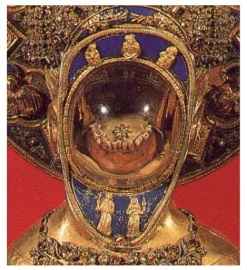1981 Recognition of the Relics of Saint Anthony

Father Vitalis Bommarco, Minister General of the Order of Friars Minor Conventual, requested authorization
from Pope John Paul II to carry out a recognition of St. Anthony's body for the occasion of the 750th anniversary
of his death. Various experts were assembled, permission, by way of a papal brief, "Sanctus Antonius" was
issued by the Pope, and on January 6, 1981, the recognition began.
Anthropometric information permitted the experts to offer a more reliable portrait of St. Anthony's appearance.
They concluded that he was about 5 feet, 6 inches tall, had an elongated face, deep set eyes, long hands and well
formed fingers, and belonged to the racial group known as the Mediterranean type. The experts also stated that
he was about 39 years and 9 months at the time of his death in 1231, which would place his birth in the year 1191,
and not 1195 as is most commonly referenced.
Additional information found was that St. Anthony had enlarged knees, and exceptionally developed
leg bones. It was also discovered that his vocal chords were still recognizable, which led the experts to believe
that the entire vocal system was probably still intact when St. Bonaventure discovered Anthony's incorrupt
tongue during the first recognition in 1263, thirty-two years after his death.

Regarding the recognition of 1263, it was at that time that the jaw of the
Saint was removed, so when no jaw was found during this recognition, there
was no cause for alarm. The jaw is on display at the Basilica of the Saint, in
Padua, Italy, and is housed in a reliquary which was given to the Basilica by
Cardinal Guido de Boulogne, in thanksgiving for favors received through
the Saint's intercession. (See picture at right).
The recognition lasted from January 6, to January 31, 1981, and the relics remained on display to the public until
March 1, 1981. Originally the relics were to be reenclosed in the altar-tomb on February 15, but the demand to
see the relics was so overwelming, that it was decided to postpone the reenclosure for two weeks.

The incorrupt tongue of Saint Anthony,
discovered during the first recognition in 1263.
On display at the Basilica of the Saint, in Padua, Italy.



